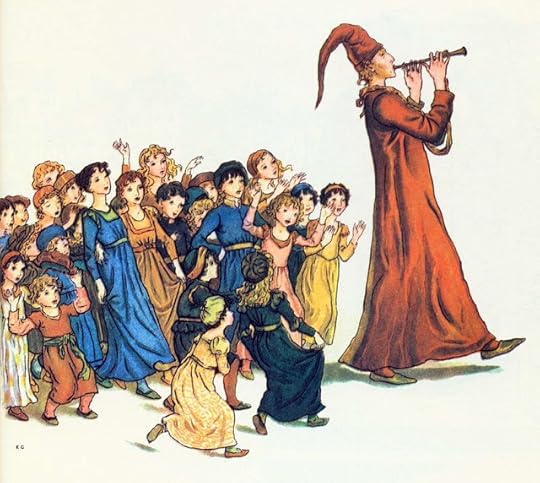In the Time of The Pied Piper of Hamelin By Mary Ann Bernal. #history behind the #fairytale #Germany @BritonandDane
In the Time ofThe Pied Piper of Hamelin
By Mary Ann Bernal

Most people are familiar with the Brothers Grimm tale of the Pied Piper of Hamelin. As the story goes, when the Piper did not receive payment from the town of Hamelin after he had rid them of their rat problem, he absconded with the children who were never seen again.
Was this fairytale that was meant to scare children fact or fiction? As with many fables, there is some truth to the story relating to events occurring in the thirteenth century.

Hamelin (Hameln as it is called in German) is a town on the river Weser, located in the Lower Saxony region of Germany. The settlement arose around the Abbey of St. Boniface that had been founded by the monks of Fulda in the latter part of the eighth century.
Fulda, in central Germany, was a flourishing city built on the Fulda River. During its heyday, it was well-known for its great library, but the school was an important seat of learning, drawing students from afar. A Benedictine Abbey was established towards the end of the eighth century and became a renowned missionary center. A replica of the Old St. Peter’s Basilica in Rome had been built to properly honor the relics of St. Boniface buried within the crypt. Pilgrims journeyed to the church praying for miracles. As time passed, the coffers were overflowing and these funds were used to set up daughter houses such as the Abbey located in Hamelin.
Even though Hamelin was a prosperous corn-trading mill town, the majority of people lived in poverty. Famine and disease plagued the less fortunate who could not feed their children. There was also the constant threat of war with nobles trying to annex more land to their territories. Add an infestation of rats to an already volatile environment caused concern among government officials. The logical thing to do was seek the services of a professional rat catcher.
Enter a piper, who convinced the officials he could rid the place of the vermin with his music for a fee. While skeptical, the bureaucrats agreed, and much to their surprise, the man was successful. However, they refused to pay him. The piper threatened to take all the children if he was not paid for his services. When payment was not received, the piper, true to his word, left the town along with the children.
According to historical accountants, the children of Hamelin did disappear and there have been many theories over the years as to what truly happened.
As in the Hansel and Gretel fairytale, it has been stated that parents had no problem getting rid of their children for a multitude of reasons. It is possible that the Pied Piper story was created to take attention away from the parents’ culpability and place the blame elsewhere.
Rats with their plague-carrying fleas may have caused the children’s demise, but the pestilence had yet to run rampant throughout Europe during the period in question.
Another theory suggested that the children may have run off to join the Children’s Crusade on their own volition. The Crusade was established to free the Holy Land from Muslim occupation. Whether or not children actually reached Jerusalem is up for debate, but reports of bands of poor people, not necessarily lone children, had been seen wandering throughout the region at that time.
Since the legend references the children dancing to the tune of the Pied Piper, suffering from a dancing plague, referred to as St. Vitus ’ dance, has also been suggested. This illness might have been caused by the toxicity of ergot fungi, but again, this is conjecture.
Of interest, is the mention of three disabled children (lame, deaf and blind) that were allegedly left behind.
The finer points vary, depending on which version is followed.
Whatever happened to the children remains a mystery but modern Hamelin continues to keep the legend alive. A major tourist attraction, the town is renowned throughout the world.
On any given Sunday from May through September, re-enactors bring the fairytale to life. If you visit off-season, there is a museum that features an animated film of the story.

The missing children have not been forgotten over the centuries because the legend continues to enthrall its audience.
References Pied Piper ~ Wikipedia Hamelin Town Replica ~ Wikipedia
Piper House ~ Wikipedia
Rat whistle 5”x4 made from clay ~ Courtesy © Elisabeth Marrion Printed with permission.
Mary Ann Bernal
 Mary Ann Bernal, author of The Briton and the Danenovels and the Scribbler Talesseries, is an avid history buff who also enjoys science fiction. She is a passionate supporter of the U.S. military, having been involved with letter writing campaigns and other military support programs since Operation Desert Storm. All of Mary Ann’s novels and short story collections are dedicated to fallen military heroes who gave their lives defending our freedom. A prolific writer originally hailing from New York, Mary Ann now resides in Nebraska.
Mary Ann Bernal, author of The Briton and the Danenovels and the Scribbler Talesseries, is an avid history buff who also enjoys science fiction. She is a passionate supporter of the U.S. military, having been involved with letter writing campaigns and other military support programs since Operation Desert Storm. All of Mary Ann’s novels and short story collections are dedicated to fallen military heroes who gave their lives defending our freedom. A prolific writer originally hailing from New York, Mary Ann now resides in Nebraska.Learn more about the author’s background and interests at maryannbernal.com and whisperinglegendspress.com.

Amazon US Amazon UK Smashwords Barnes & Noble
Published on January 18, 2018 23:00
No comments have been added yet.
The Coffee Pot Book Club
The Coffee Pot Book Club (formally Myths, Legends, Books, and Coffee Pots) was founded in 2015. Our goal was to create a platform that would help Historical Fiction, Historical Romance and Historical
The Coffee Pot Book Club (formally Myths, Legends, Books, and Coffee Pots) was founded in 2015. Our goal was to create a platform that would help Historical Fiction, Historical Romance and Historical Fantasy authors promote their books and find that sometimes elusive audience. The Coffee Pot Book Club soon became the place for readers to meet new authors (both traditionally published and independently) and discover their fabulous books.
...more
...more
- Mary Anne Yarde's profile
- 159 followers



